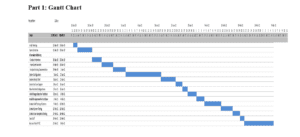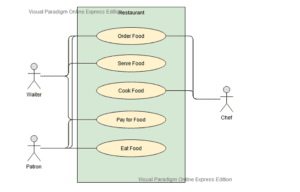Technical Paper: Proof of Concept (POC) Your company is a 4-year-old startup called XYZ Software Enterprises. XYZ produces a point of sale system and was awarded a Proof of Concept (POC) to one of the largest and oldest restaurants in the industry (you know, the ones in the commercials all the time). The restaurant wants XYZ to prove that the software will do what the sales people said it could do. Your Proof of Concept will include four parts: Proof of Concept Proof of Concept Part 1: Gantt Chart Part 2: Testing and User Acceptance Report Part 3: Use Case Diagram Part 4: Activity Diagram Part 1: Gantt Chart A Gantt Chart (see page 353 Figure 11-18) needs to be created for the entire process of the Proof of Concept. There is a two-month deadline from today to complete the POC. Using Visio or Excel, create a Gantt Chart that includes all of the items listed below and adds five more tasks minimum from the concepts learned from the course: The initial meeting — today. Should appear a
Proof of Concept
Part 1: Gantt Chart

Gantt Chart
Part 2: Testing and User Acceptance Report
System and Stress Testing
One of the required testing processes that are conducted during the development of a project includes system testing. System testing involves the process of testing whether the whole system is capable of performing the intended functions. Different individuals can conduct the process of conducting system testing. These can include members of the team responsible for developing the system or professional testers who are noted to create better testing environments when compared to the individuals responsible for developing the system (Talby, Keren, Hazzan, & Dubinsky, 2006). Like system testing, stress testing is another type of testing that is required. Čihák (2007) includes the process of testing a system to determine how to system will behave when presented with adverse conditions. Stress testing is used to determine how stable and reliable a system will be, especially when the system is presented with adverse conditions. The industry leaders might require the system and stress tests to determine whether the developed system will be able to conduct all the intended functions or continue to function when presented with different challenges. The process of conducting system and stress testing can be improved by identifying the best test environments for conducting either of the tests. This is then followed by determining the criteria by which the system and stress tests will determine whether they were a success. The criteria for determining the success of the tests should also include the design of the tests.
User Acceptance Testing
The industry leaders might also require user acceptance testing besides the system and stress tests. Unlike stress and system tests, user acceptance testing is not conducted by the individuals that develop the system or professional testers but by the end-users or the clients. User acceptance testing aims to determine whether the defined requirements for the end-users have been met (Hambling & Van Goethem, 2013). It also addresses the ease with which the users are able to use the system. Industry leaders might be interested in user acceptance testing due to its importance in determining the success of the system. When the users cannot use the system or find that some of the functionalities are not present, the system is likely to fail. However, the success of the system can be determined when the user acceptance testing is successful. One of the best practices when conducting user acceptance testing is ensuring that the end-users identified to conduct the testing process are representative of the target market that are likely to become the system’s end-users. An example of this for the XYZ Software Enterprise, having the employees of the restaurant conduct user acceptance testing can be essential in determining whether the users at the restaurant will be able to use the developed system effectively.
Part 3: Use Case Diagram

Case Diagram
Part 4: Activity Diagram

Activity Diagram
References
Čihák, M. (2007). Introduction to applied stress testing. IMF Working Papers, 1-74.
Hambling, B., & Van Goethem, P. (2013). User acceptance testing: a step-by-step guide. BCS Learning & Development.